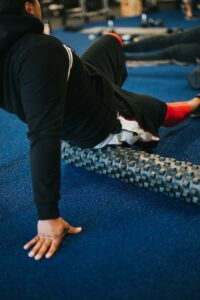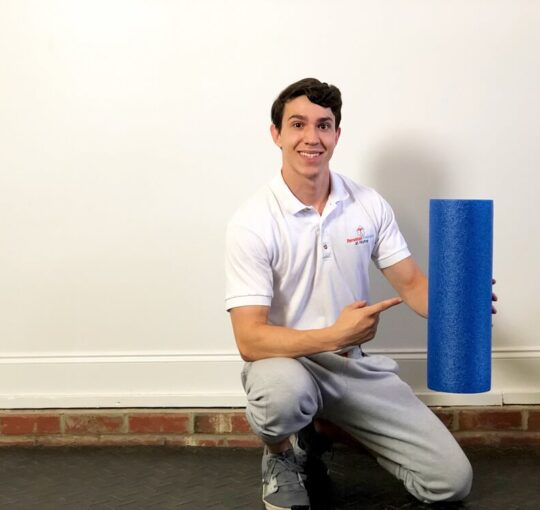The benefits of foam rolling is perhaps one of the most overlooked components of a well rounded fitness approach.
From personal observation it’s very commonly done wrong as well.
Not only can it provide short term relief, but it can be an edge you may need to finally feel better long term!
My goal for this article is to answer the following questions (and maybe a few more!):
- What does foam rolling do?
- Does foam rolling actually work?
- What are the benefits of foam rolling?
- Why does foam rolling hurt?
- Can foam rolling be harmful?
- How often should you foam roll?
- How long should you foam roll?
What Does Foam Rolling do?
If I had to sum up what foam rolling does into one sentence it would be:
Foam rolling alleviates the pain and stiffness of trigger points.
As a personal trainer though, this isn’t why I have most of my clients foam roll and this certainly is why I was trained to prescribe it either!
Without trying to get too information heavy let’s break this down to get to the real value of foam rolling.
The Cumulative Injury Cycle
Poor posture, repetitive movements, and injuries to soft tissue will initiate a repair process termed “The Cumulative Injury Cycle”.
In chronological order it looks like this:
- Tissue Trauma
- Inflammation
- Muscle Spasm (micro spasms)
- Adhesions
- Altered Neuromuscular control
- Muscle Imbalance
The adhesions formed within the cumulative injury cycle will eventually become inelastic causing further damage and dysfunction which can include:
- Pain and stiffness (loss of mobility)
- Movement compensations
- Elevated risk of further injuries
What Does This Mean for you?
This means that foam rolling can serve as a way to decrease pain and stiffness to allow better restoration of your mobility and proper movement patterns.
What are the Benefits of Foam Rolling?
This was partially answered in the previous section, but here are further benefits of foam rolling accompanied with its primary use:
- Healthier tissue to avoid injuries and improve recovery from training
- Decreased pain, stiffness, and muscle soreness
- Improved mobility
- Aid in restoring proper movement
Does Foam Rolling Work?
You might be thinking to yourself, “The benefits of foam rolling sounds great and all, but is there actually science behind foam rolling?”
The answer is yes, there is supportive evidence.
One study done by Hou and colleagues found that pressure with a minimal pain threshold and high duration (90 seconds) or pressure with a high pain threshold and low duration (30 seconds) significantly reduced pain and trigger point sensitivity.
This same study also found that combining stretching techniques significantly improved range of motion!
There have been many other studies done showcasing the power of self myofascial release (SMR) and its effects to relieve pain and stiffness!
By the way, SMR would be the technical term within this context. Foam rolling is within the family of self myofascial release techniques.
How to use a Foam Roller
Two common questions when it comes to foam rolling is:
How long should I foam roll?
And
How often should I foam roll?
When answering these two questions I will actually be able to tell you how to foam roll as a whole. Let’s dive in!
How Long Should I Foam Roll?
Once you have figured out what muscles you want to roll, you will want to roll down the length of that muscle slowly.
If you roll too fast this could promote excitation of the muscle tissues is this is what you don’t want!
As you roll, you are looking for trigger points. You will know you have found a trigger point when you come across an area with heightened sensitivity.
Once you’ve found a trigger point, you will want to hold sustained pressure on that spot. You can do this for every trigger point you find.
If the pain intensity is high, then hold for closer to 30 seconds. If the pain intensity is low, you can hold for up to 90 seconds!

The duration you decide to stay on the foam roller will be linked to the intensity of the pain from the trigger point.
Foam rolling newbies should start with a soft foam roller that generally has a larger diameter.
As you begin to get more advanced, you can switch to firmer foam rollers that are generally smaller in diameter.
How Often Should I Foam Roll?
At this time from what we know, there’s no reason why you couldn’t foam roll daily unless you were specified not too!
Depending on when you foam roll will also be related to your goals.
You could use foam rolling as a short term solution for pain or muscle soreness. I struggle with short term solutions as a personal trainer because you’re treating the symptoms and not the cause (muscle soreness is different).
In this case though, you can foam roll when you decide is best.
If you are planning to include foam rolling into your workout routine, then you will typically add it in before or after.
Foam rolling before exercise for muscle groups you know are tight is a great start and a highly recommended approach.
You can foam roll post workout too though to promote recovery and again aid in gaining mobility.
With my clients I will typically have them roll out before their workout.
Who Shouldn’t Foam Roll?
Foam rolling hurts, so can it be harmful?
Foam rolling is safe when done properly. A few immediate things to know and look out for are:
- If you are experiencing a numb and tingling sensation that may shoot to another area of your body, then you are probably on a nerve . . . this is not good!
- Referred pain is ok however. This is pain you may experience in another part of the muscle you are rolling; even if you aren’t on that trigger point. This can happen in very tight muscles especially.
- You won’t want to foam roll the low back or neck, however you can use other SMR techniques for these regions. These areas of the body just don’t have enough surrounding musculature to safely use the foam roller on.
Contraindications
If you have any of the following on the list, you should not foam roll or use any SMR techniques unless you speak with your doctor.
| Malignancy | Goiter (Enlarged Thyroid) |
| Osteoporosis | Severe Eczema and Other Skin Lesions |
| Osteomyelitis (Infection of Bone Tissue) | Hypersensitive Skin Conditions |
| Phlebitis (Infection of Superficial Veins) | Open Wounds |
| Cellulitis (Infection of Soft Tissue) | Healing Fractures |
| Acute Rheumatoid Arthritis | Obstructive Edema |
| Blood Clot | Advanced Diabetes |
| Aneurysm | Hematoma or Systemic or Localized Infection |
| Anticoagulant Therapy | Febrile State |
| Bursitis | Advanced Degenerative Changes |
| Sutures | Organ Failure |
| Congestive Heart Failure | Bleeding Disorders |
Foam Rolling is Beneficial!
Overall, foam rolling is a valuable component to add into your fitness approach!
You will experience less muscle pain and stiffness and gain an edge towards your goals! This is an amazing benefit of foam rolling!
Have you tried foam rolling and what were your results?
Sources:
- Clark, Michael, et al. NASM Essentials of Corrective Exercise Training. Jones and Barlett Lerning, 2014.
- Hou C-R, Tsai L-C, Cheng K-F, Chung K-C, Hong C-Z. Immediate Effects of Various Therapeutic modalities on cervical myofascial pain and trigger point sensitivity. Arch Phys Med Rehabil. 2002;83:1406-1414

